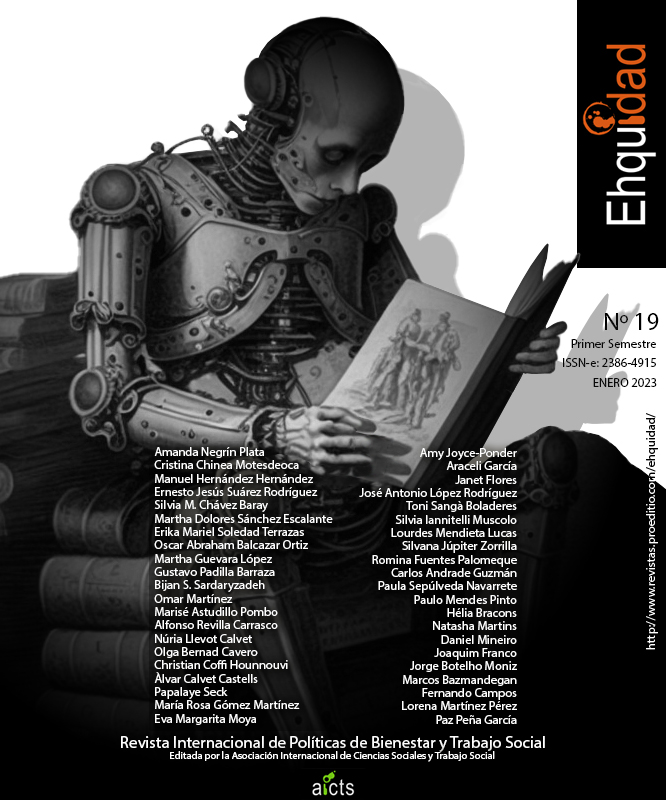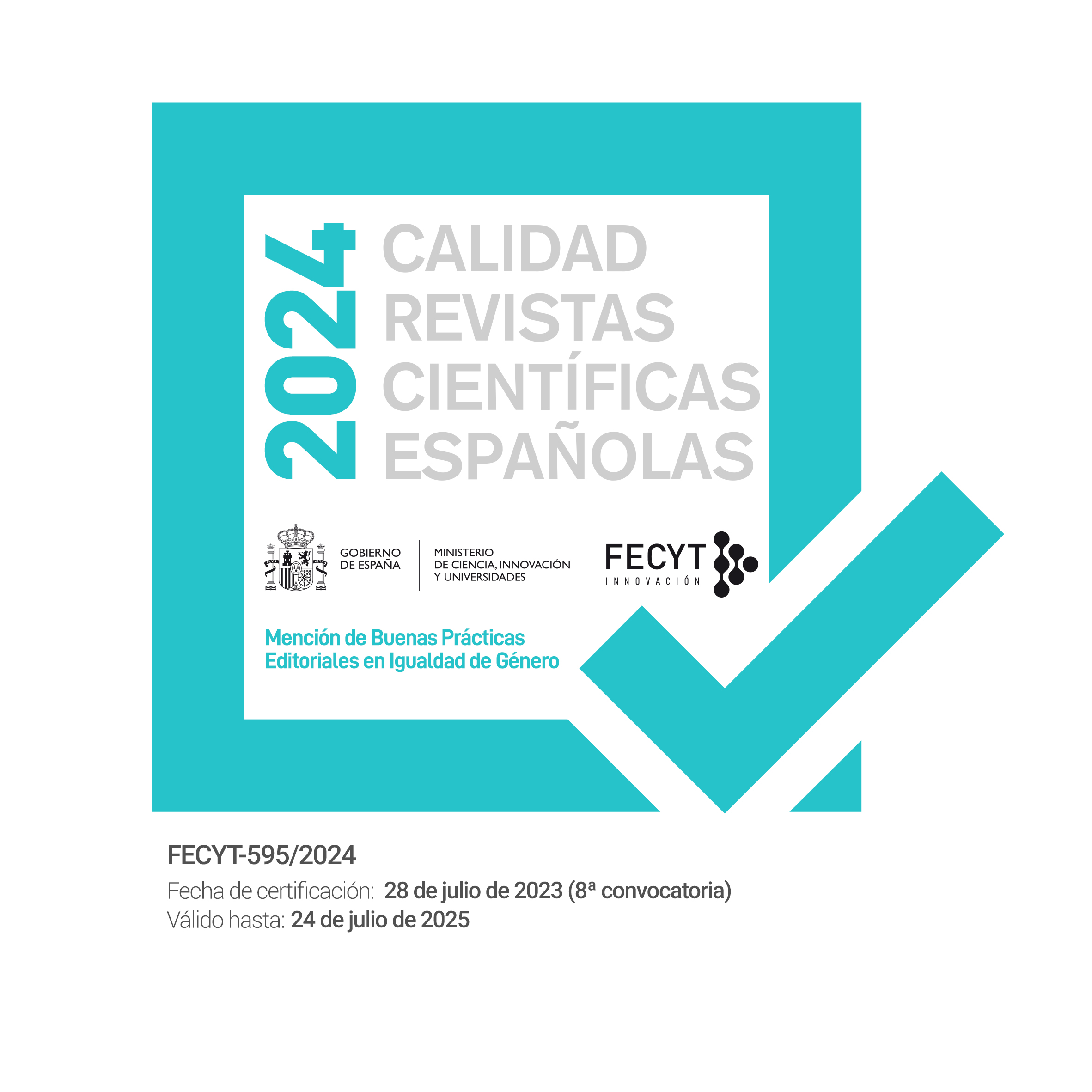Relationship between Individual and Community Resilience in Environmentally Vulnerable Populations
DOI:
https://doi.org/10.15257/ehquidad.2023.0001Keywords:
Resiliencia invididual, Resiliencia comunitaria, Amenaza natural, Liderazgo y empoderamiento, Compromiso comunitarioAbstract
This research aims to analyse the relationship between Individual Resilience, as measured by the CD-RISC-10 scale (Campbell and Stein, 2007) and Community Resilience, as measured by the Index of Perceived Community Resilience (IPCR, Kulig et al., 2013), in a sample of 387 people living on the island of Bali (Indonesia). The population of this area regularly faces the consequences of natural disasters, such as earthquakes, volcanic eruptions and severe floods. A Confirmatory Factor Analysis of the IPCR was carried out, which confirmed the multidimensional structure of Community Resilience originally proposed by its authors. Results also showed that there is a positive and moderate correlation between Individual and Community Resilience. Specifically, regression analysis showed that the three Community Resilience factors explain 32% of Individual Resilience, although Leadership followed by Community Engagement are the two factors that provide the most explanatory power.
Downloads
References
Akter, S., Dhar, T. K., Rahman, A. y Uddin, M. K. (2021). Investigating the resilience of refugee camps to COVID-19: A case of Rohingya settlements in Bangladesh. Journal of Migration and Health, 4, 1-16. https://doi.org/10.
/j.jmh.2021.100052.
Alameldeen, A. y Cakan, Z. (2021). What is a Resilient Community? Academia Letters, Article 3615. 1-9. https://doi.org/10.20935/AL3615.
Alzugaray C. (2019) Resiliencia Comunitaria ante Adversidades Colectivas: Restaurando el Bienestar Psicosocial. [Tesis doctoral, Universidad del País Vasco].
Amir, M.T. y Standen, P. (2012). Employee resilience in organizations: Development of a new scale. https://www.researchgate.net/publication/
Apriani F. y Arruum Listiyandini R. (2019). Kecerdasan emosi sebagai prediktor resiliensi psikologis pada remaja di panti asuhan. Jurnal Psikologi Indonesia, 8(2), 325-339. https://doi.org/10.30996/persona.v8i2.2248.
Boomsma, A. y Hoogland, J. J. (2001). The robustness of LISREL modeling revisited. In R. Cudeck, S. du Toit y D. Sörbom (Eds.), Structural Equation Models: Present and Future. A Festschrift in Honor of Karl Jöreskog (pp. 139–168). Scientific Software International. https://www.researchgate.net/
publication/237462497.
Braun-Lewensohn, O. y Sagy, S. (2013). Community Resilience and Sense of Coherence as Protective Factors in Explaining Stress Reactions: Comparing Cities and Rural Communities During Missiles Attacks. Community mental health journal. 50, 229–234. https://doi.org/10.1007/s10597-013-9623-5.
Buikstra, E., Ross, H., King, C. A., Baker, P. G., Hegney, D., McLachlan, K. y Rogers-Clark, C. (2010). The components of resilience-perceptions of an Australian rural community. Journal of Community Psychology, 38(8), 975-991. https://doi.org/10.1002/jcop.20409.
Campbell-Sills L. y Stein M.B. (2007). Psychometric analysis and refinement of the Connor-davidson Resilience Scale (CD-RISC): Validation of a 10-item measure of resilience. Journal of Traumatic Stress, 20(6), 1019–1028. https://doi.org/10.1002/jts.20271.
Campo, R., Granados, L.F., S.J., Muñoz, L., Rodríguez, M. S. y Trujillo, S. (2012). Caracterización del avance teórico, investigativo y/o de intervención en resiliencia desde el ámbito de las universidades en Colombia. Universitas Psychologica, 11(2), 545-557. https://doi.org/10.11144/Javeriana.upsy11-2.cati.
Cénat, J. M., Dalexis, R., Derivois, D., Hébert, M., Hajizadeh, S., Kokou-Kpolou, C. K., Guerrier, M. y Rousseau, C. (2021). The transcultural community resilience scale: psychometric properties and multinational validity in the context of the COVID-19 pandemic. Frontiers in Psychology, 12, 1-10. https://doi.org/10.3389/fpsyg.2021.713.
Clarke, J.L. (2020). Investigating Wildfire as a Catalyst for Community-Level Resilience. Graduate Student Theses, Dissertations & Professional Papers. 11614. https://scholarworks.umt.edu/etd/11614.
Connor, K. y Davidson, J. (2003). Development of a new resilience scale: The Connor-Davidson Resilience Scale (CD-RISC). Depression and anxiety, 18, 76-82. https://doi.org/10.1002/da.10113.
Efron, B. y Tibshirani, R. (1986). "Bootstrap Methods for Standard Errors, Confidence Intervals and Other Measures of Statistical Accuracy." Statist. Sci. 1(1), 54–75. https://doi.org/10.1214/ss/1177013815.
Eshel Y. y Kimhi S. (2009). Individual and Public Resilience and Coping With Long?Term Outcomes of War. Journal of Applied Biobehavioral Research 14(2), 70–89. https://doi.org/10.1111/j.1751-9861.2009.00041.x
Eshel, Y. y Kimhi, S. (2016a). Postwar Recovery to Stress Symptoms Ratio as a Measure of Resilience, Individual Characteristics, Sense of Danger, and Age. Journal of Loss and Trauma: International Perspectives on Stress & Coping, 21(2), 160–177.
https://doi.org/10.1080/15325024.2014.965970.
Eshel, Y. y Kimhi, S. (2016b). Determinants of individual resilience following missile attacks: A new perspective. Personality and Individual Differences, 95, 190–195. https://doi.org/10.1016/j.paid.2016.02.052.
Fernández-Prados, J.S., Lozano-Díaz, A. y Muyor-Rodríguez, J. (2020): Factors explaining social resilience against COVID-19: the case of Spain. European Societies, 23(Sup.1), S111-S121. https://doi.org/10.1080/146166.
1818113.
Fletcher, D. y Sarkar, M. (2013). Psychological resilience: A review and critique of definitions, concepts, and theory. European Psychologist, 18(1), 12–23. https://doi.org/10.1027/1016-9040/a000124.
García-León, M.A., González-Gómez, A., Robles-Ortega, H. Padilla, J.L. y Peralta-Ramírez, M.I. (2019). Propiedades psicométricas de la Escala de Resiliencia de Connor y Davidson (CD-RISC) en población española. Annals of psychology, 35(1), 33-40. http://dx.doi.org/ 10.6018/analesps.35.1.31411.
Gaxiola, J. C., González, S. y Contreras, Z. (2012). Influencia de la resiliencia, metas y contexto social en el rendimiento académico de bachilleres. Revista Electrónica de Investigación Educativa, 14(1), 164-181. https://www.redaly
c.org/articulo.oa?id=15523175011.
Grotberg, E.H. (2004). Nuevas tendencias en resiliencia. A. Melillo y E.N. Suárez Ojeda, Resiliencia. Descubriendo las propias fortalezas. Editorial Paidós SAICF. 1ª Ed, 3ª Reimp. (19-30).
Hernández, J., Guàrdia, J., y San Luis, C. (1995). Acerca de la robustez de los estimadores multinormales y elípticos bajo ciertas condiciones de asimetría, tamaño muestral y complejidad de los modelos de estructuras de covarianza. Anales de Psicología, 11(2), 203–218. https://doi.org/10.6018/
analesps.
Hestyanti, Y.R. (2007). Children Survivors of the 2004 Tsunami in Aceh, Indonesia: A Study of Resiliency. Annals of the New York Academy of Sciences. 1094. 303-307. https://doi.org/10.1196/annals.1376.039.
Hu, L., y Bentler, P. (1999). Cutoff criteria for fit indexes in covariance structure analysis: Conventional criteria versus new alternatives. Structural Equation Modeling: A Multidisciplinary Journal, 6(1), 1–55. https://doi.org/10.1080 /10705519909540118.
Istanto H. (2020). Community Resilience in Post Disaster Recovery: A Case Study of Volcanic Eruptions in Indonesia. Conference: 2020th Conference on Environmental Information Science. At Japan. 34, 67-72. https://doi.org/10.11492/ceispapers.ceis34.0_67.
Jewett, R., Mah, S., Howell, N. y Larsen, M. (2021). Social Cohesion and Community Resilience During COVID-19 and Pandemics: A Rapid Scoping Review to Inform the United Nations Research Roadmap for COVID-19 Recovery. International Journal of Health Services, 51(3), 325-336. https://doi.org/10.1177/0020731421997092.
Kulig, J. y Botey, A.P. (2016). Facing a wildfire: What did we learn about individual and community resilience? Nat Hazards 82, 1919–1929. https://doi.org/10.1007/s11069-016-2277-1.
Kulig, J.C., Edge, D.S. y Joyce B. (2008). Understanding Community Resiliency in Rural Communities. Through Multimethod Research. Journal of Rural and Community Development 3(3), 76–94. https://journals.brandonu.ca/ jrcd/article/view/161.
Kulig, JC., Edge, D. y Smolenski, S., (2014). Wildfire disasters: Implications for rural nurses. Australasian Emergency Nursing Journal, Volume 17(3). 126-134. https://doi.org/10.1016/j.aenj.2014.04.003.
Kulig J.C, Edge D.S., Townshend I, Lightfoot N. y Reimer W. (2013). Community resiliency: Emerging theoretical Insights. Journal of community psychology, 41(6), 758–775. https://doi.org/10.1002/jcop.21569.
Kulig, JC., Townshend, I., Kosteniuk, J., Karunanayake, C., Labrecque M.E. y MacLeod, MLP. (2018). Perceptions of sense of community and community engagement among rural nurses: Results of a national survey. International Journal of Nursing Studies, 88, 60-70. https://doi.org/10.1016/ j.ijnurstu.2018.07.018.
Leyking, D., Lahad, M., Cohen, O., Goldberg, A. y Aharonson-Daniel, L. (2013). Conjoint community resiliency assessment measure-28/10 items (CCRAM28 and CCRAM10): a Self-report tool for assessing community resilience. American journal of community psychology, 52, 313-323. https://doi.org/10.1007/s10464-013-9596-0.
Lozano Díaz, A., Fernández-Prados, J.S., Figueredo Canosa, V. y Martínez Martínez, A.M. (2020). Impactos del confinamiento por el COVID-19 entre universitarios: Satisfacción Vital, Resiliencia y Capital Social Online. International Journal of Sociology of Education, Special Issue: COVID-19. Crisis and Socioeducative Inequalities and Strategies to Overcome them, 79-104. http://doi.org/10.17583/rise.2020.5925.
Ludin, S., Rohaizat, M. y Arbon, P. (2019). The association between social cohesion and community disaster resilience: A cross-sectional study. Health and Social Care in the Community, 27(3), 621-631. http://doi.org/10.1111/hsc.12674.
Marzana, D., Marta, E. y Mercuri, F. (2013). De la resiliencia individual a la resiliencia comunitaria. Evaluación de un proyecto de investigación-acción sobre el desamparo social de los menores. Revista Electrónica Interuniversitaria De Formación Del Profesorado, 16(3), 11-32. https://doi.org/10.6018/reifop.16.3.186961.
Mason, L.R, Kemp, S.P., Palinkas, L.A. y Krings A. (2021). Social responses to a changing environment. Encyclopedia of Social Work. Retrieved from Loyola eCommons, Social Work: School of Social Work Faculty Publications and Other Works. https://doi.org/10.1093/acrefore/9780199975839.013.14 31.
Mujahidah E. y Arruum Listiyandini R. (2018). Pengaruh Resiliensi dan Empati terhadap Gejala Depresi pada Remaja. Jurnal Psikologi, 14(1), 60-75. https://doi.org/10.24014/jp.v14i1.5035.
Norris, F. H., Stevens, S. P., Pfefferbaum, B., Wyche, K. F. y Pfefferbaum, R. L. (2008). Community resilience as a metaphor, theory, set of capacities, and strategy for disaster readiness. American Journal of Community Psychology, 41, 127–150. https://doi.org/10.1007/s10464-007-9156-6.
Oficina Central de Estadísticas de Indonesia (2021). https://www.bps.go.id/.
Olsson, C. A., Bond, L., Burns, J. M., Vella-Brodrick, D. A. y Sawyer, S. M. (2003). Adolescent resilience: A concept analysis. Journal of Adolescence, 26(1), 1–11. https://doi.org/10.1016/S0140-1971(02)00118-5.
Pfefferbaum, R. L., Pfefferbaum, B., Van Horn, R. L., Klomp, R. W., Norris, F. H. y Reissman, D. B. (2013). The communities advancing resilience toolkit (CART): An intervention to build community resilience to disasters. Journal of Public Health Management and Practice, 19, 250–258. https://doi.org/10.1097/PHH.0b013e318268aed8.
Romero-Saldaña, M. (2016). Pruebas de bondad de ajuste a una distribución normal. Revista Enfermería del Trabajo, 3, 105-114. https://dialnet.unirioja.es/descarga/articulo/5633043.pdf.
Ruiz Pérez, J. I. (2015). Resiliencia comunitaria: propuesta de una escala y su relación con indicadores de violencia criminal. Pensamiento Psicológico, 13(1), 119-135. https://doi.org/10.11144/Javerianacali.PPSI13-1.rcpe
Rutter, M. (1985). Resilience in the face of adversity: Protective factors and resistance to psychiatric disorder. The British Journal of Psychiatry, 147, 598–611. https://doi.org/10.1192/bjp.147.6.598
Sakti Kaloeti D.V., Rahmandani, A., Salma Salma, H.S., Suparno Suparno y Sekar Hanafi (2018). Effect of childhood adversity experiences, psychological distress, and resilience on depressive symptoms among Indonesian university students, International Journal of Adolescence and Youth, 1-8. https://doi.org/10.1080/02673843.2018.1485584.
Soler Sánchez, M.I., Meseguer de Pedro, M. y García Izquierdo, M. (2016) Propiedades psicométricas de la versión española de la escala de resiliencia de 10 ítems de Connor-Davidson (CD-RISC 10) en una muestra multiocupacional. Revista Latinoamericana de Psicología, 48(3), 159-166. http://dx.doi.org/10.1016/j.rlp.2015.09.002.
Streb, M., Häller, P. y Michael, T. (2014). PTSD in paramedics: resilience and sense of coherence. Behavioural and cognitive psychotherapy, 42, 452–463. https://doi.org/10.1017/S1352465813000337.
Syukrowardi, D. A., Wichaikull, S. y Von Bormann S. (2015). Predictors of resilience in children after expose to flooding in Indonesia. J Health Res, 29(Suppl.1), S15-22. https://doi.org/10.14456/jhr.2015.44.
Thibodeaux J. (2021). Conceptualizing multilevel research designs of resilience. Journal of Community Psychology 49(1). https://doi.org/10.1002/jcop.22598.
Ungar, M. (2011). The Social Ecology of Resilience: Addressing Contextual and Cultural Ambiguity of a Nascent Construct. The American journal of orthopsychiatry. 81(1). 1-17. https://doi.org/10.1111/j.1939-0025.2010. 01067.x
Ungar M. y Theron L. (2020). Resilience and mental health: how multisystemic processes contribute to positive outcomes. Lancet Psychiatry, 7(5). 441-448. https://doi.org/10.1016/S2215-0366(19)30434-1.
Vera Poseck, B., Carbelo Baquero, B. y Vecina Jiménez, M.L. (2006). La experiencia traumática desde la psicología positiva: resiliencia y crecimiento postraumático. Papeles del Psicólogo, 27(1), 40-49. http://www.cop.es/papeles.
Werner, E. y Smith, R. (1982). Vulnerable but invincible: A longitudinal study of resilient children and youth. New York: Adams, Bannister and Cox.












